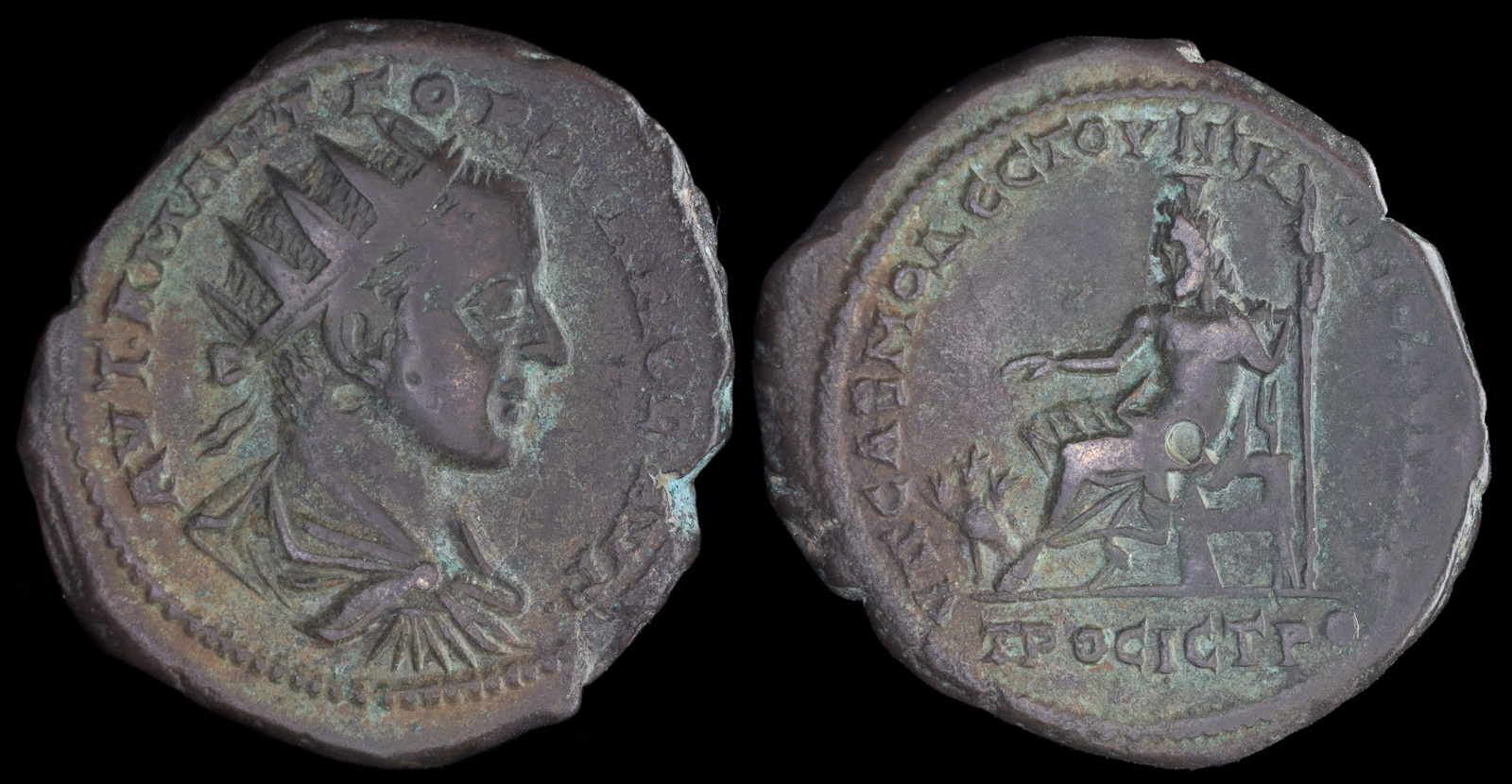
Moesia Inferior, Nikopolis ad Istrum
Gordian III 238-244 CE
Sabinus Modestus, legatus Augusti pro praetore.
Æ 29mm, 12,67g
Obv: ΑΥΤ Κ Μ ΑΝΤ ΓΟΡΔΙΑΝΟϹ ΑΥΓ. Laureate, draped and cuirassed bust right
Rev: ΥΠ ϹΑΒ ΜΟΔЄϹΤΟΥ ΝΙΚΟΠΟΛЄΙΤΩΝ ΠΡΟϹ ΙϹΤΡΟ. Serapis seated left, extending arm over Cerberus, and holding sceptre
RPC VII.2 1300; AMNG 2046
I must admit that I purchased this coin to complete my “12 gods of Olympus” collection, which it didn’t, and because it’s an extremely rare depiction of Hades and Kerberos, which it technically isn’t.
This is actually a depiction of Serapis, a deity “invented” by Ptolemy I to combine the Egyptian Apis with the Greek Hades. The two were very similarly depicted, but Serapis wore a little hat called a “modius”, so called because it resembles a jar used for measurement.
Serapis and Hades were both basically rulers of the underworld, but Serapis was a bit “friendlier” in promoting fertility and the afterlife, and thus he was a bit less scary to worship. In fact, temples to Serapis eventually spread throughout the Roman Empire, and evidently hit Nicopolis ad Istrum too, where this coin was minted.
In terms of finishing my “12 gods of Olympus” collection, neither Hades nor Serapis numbered among them because neither lived on Olympus, duh! On the positive side, I hadn’t realized I’d already completed that collection when I added an image of Vulcan.
Still, I really love the image, and whether you see the throned subject as Hades or Serapis, you have to sympathize for him. First, he was a dog owner, and not only that – he had a special needs dog.
Think about the travails of owning a three-headed dog. What happened if three squirrels ran in different directions? That could be seriously disconcerting, and must have required significant care and diligence in the owner. Clearly Hades couldn’t have been that bad of a guy, though he may have been a bummer at parties.
Another interesting aspect of this coin is it continues a common practice at Nicopolis ad Istrum of minting coins based on statues. In this case, it’s a well-known statue of Serapis sculpted in the 3rd century BCE by Bryaxis. We don’t believe to have the original, but numerous copies are in museums and no doubt one was used as the model for this coin.
Bryaxis is most known for creating the sculptures on the north side of the mausoleum of Maussollos at Halikarnassos, one of the ancient seven wonders of the world. Queen Artemisia II comissioned the four greatest sculptors of the time (the others being Leochares, Scopas, and Timotheos) to each carve one side. He also carved a bronze statue of Seleukos Nikator, five statues at Rhodes, and a statue of Apollo at Daphne at Antioch. Some scholars, however, do not believe Bryaxis carved the Serapis statue at Alexandria that this coin copies, but I’m going to ignore that research because it makes my story less interesting.
Some sculptures from the Mausoleum of Halikarnassos have been found, but we don’t know which side they adorned, and thus which sculptor created them. The Statue of Serapis at Alexandria has not survived. The temple was destroyed in 391 CE by Emperor Theodosius I, though some substructures and a column remain. At the time this coin was minted, though, the temple and presumably the statue were still standing.